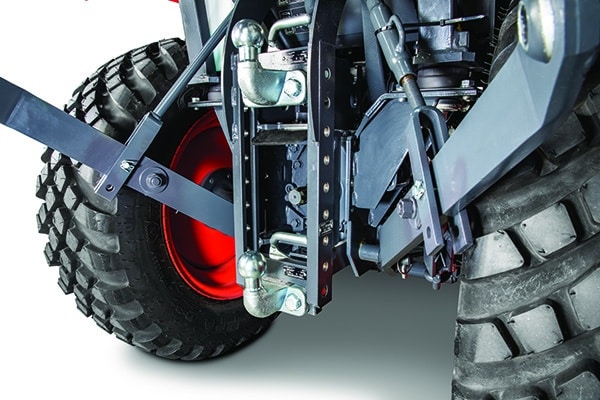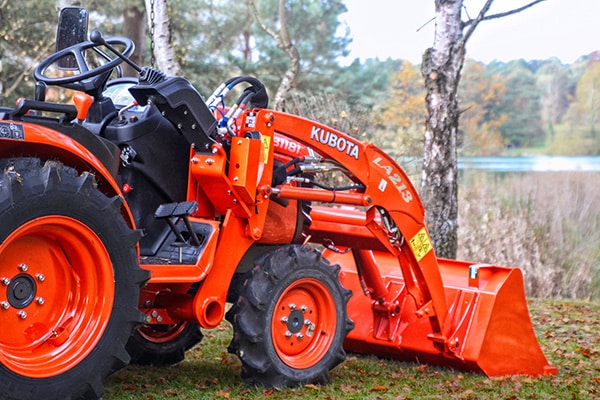Choosing a Compact Tractor and what to consider

What are compact tractors?
 In essence a compact tractor is a multi-tool which has been designed to carry out a wide range of different tasks. They come in all different shapes and sizes, usually 15 to 60 HP (horse power) in order to suit different customer types subject to their specific requirements and budget. Nowadays, most reputable brands come with power steering and are fitted with a rear 3-point linkage which gives the ability to fit different attachments (implements) to the back of the tractor. These are usually powered by a rear PTO (power take off) some of which have a dual-speed function to enable you to operate certain implements at a slower RPM (revolutions per minute).
In essence a compact tractor is a multi-tool which has been designed to carry out a wide range of different tasks. They come in all different shapes and sizes, usually 15 to 60 HP (horse power) in order to suit different customer types subject to their specific requirements and budget. Nowadays, most reputable brands come with power steering and are fitted with a rear 3-point linkage which gives the ability to fit different attachments (implements) to the back of the tractor. These are usually powered by a rear PTO (power take off) some of which have a dual-speed function to enable you to operate certain implements at a slower RPM (revolutions per minute).
Compact tractors are usually broken down into two different category types which are designed for different applications; these are usually a ‘manual’ gear drive or a ‘hydrostatic’ oil drive. Each design has different advantages and disadvantages, so it’s important to do your research and seek the correct technical advice before making a sizeable investment.
What are the benefits of compact tractors?
 Flexibility is the main advantage of a compact tractor; in effect you are investing in a ‘ride on’ swiss army knife that is capable of carrying out many tasks. There are many different implements available that can be sourced for different jobs such as; mowing and collecting various types of grasses, ground cultivation and preparation work, transportation of materials, spraying and spreading of materials, timber handling and chopping, sweeping and winter maintenance jobs, to name but a few. The size of the implement will usually be determined by the size and HP output of the tractor you are using.
Flexibility is the main advantage of a compact tractor; in effect you are investing in a ‘ride on’ swiss army knife that is capable of carrying out many tasks. There are many different implements available that can be sourced for different jobs such as; mowing and collecting various types of grasses, ground cultivation and preparation work, transportation of materials, spraying and spreading of materials, timber handling and chopping, sweeping and winter maintenance jobs, to name but a few. The size of the implement will usually be determined by the size and HP output of the tractor you are using.
In most cases you will have the ability to fit a front loader and bucket for loading and transporting materials, an example would be loading salt into a gritting machine or removing horse manure from a stable. In tractors above 30 HP most reputable manufacturers will usually be able to offer a quick attach system which will allow you to easily fit different implements to your loader carriage, for example a snow plough, loading bucket or a set of pallet forks for lifting and transporting.
 Some higher specification models also come fitted with a mid PTO which gives the option to fit a mowing deck underneath which is particularly common for someone who may be mowing a paddock and doesn’t need to collect the grass. Also for someone who may want to add a large collector on the back of the machine so they can cut and collect in one operation, usually this is a good way to increase productivity when working in a large area as it covers two jobs in one.
Some higher specification models also come fitted with a mid PTO which gives the option to fit a mowing deck underneath which is particularly common for someone who may be mowing a paddock and doesn’t need to collect the grass. Also for someone who may want to add a large collector on the back of the machine so they can cut and collect in one operation, usually this is a good way to increase productivity when working in a large area as it covers two jobs in one.
What is the difference between a sub-compact tractor and a compact tractor?
A sub-compact tractor is what would be best described as a ‘halfway house’ between a ride on mower and a compact tractor. They are often a popular choice with owners of small holdings or for equestrian centres and contractors, however they do have their limitations and are not ‘all things to all men’ which is often a common misconception.
The first main difference is the physical size of the tractor. Usually sub-compacts are limited to 20-26 HP and are smaller in size when compared to a standard compact tractor of the same HP rating. However, this does mean they are usually more nimble when it comes to getting into tighter spaces and they are also lighter so are generally more forgiving on turf and don’t leave as big a footprint. The wheels are much smaller on a sub-compact which means less ground clearance and the lift capacity capability will be considerably less due to a limited oil flow pump capacity and the fact the tractor is physically smaller and therefore less stable.
What is the difference between a utility compact tractor and a compact tractor?
 A utility tractor is what is best described as a more basic, functional version of a standard compact tractor, minus ‘the bells and whistles’ such as a fancy cab with air conditioning or an air seat. In a lot of cases these extras are not essential and are often what you are paying a premium for.
A utility tractor is what is best described as a more basic, functional version of a standard compact tractor, minus ‘the bells and whistles’ such as a fancy cab with air conditioning or an air seat. In a lot of cases these extras are not essential and are often what you are paying a premium for.
For people who are working to a limited budget or don’t want anything that is too complicated, a utility tractor will meet all of your requirements. If you are looking for a solid tractor that keeps going all day long you won’t go far wrong with a utility tractor such as the Kubota L1361 or similar.
How to choose a compact tractor?
The first and most important thing is to seek professional advice from your local dealership. Often customers ask for a price on a particular model of tractor only to find that what they are asking for is not what they actually require, potentially a costly mistake! Try and provide the sales person at the dealership with as much information as possible, i.e. budget, what jobs you are looking to do with the machine and the type of terrain you are working on.
Always ask the dealer sales representative to do a site visit, this will give you the best chance of gaining the correct advice and getting the best value. As a general rule a ‘manual’ tractor is usually better suited to ground preparation work such as cultivating or spraying, mainly because you can control your working speed far better which is imperative when working is confined spaces or if you are looking to lay down sand or fertiliser and want to calibrate your spread rate. A ‘hydro’ tractor’ is more suited to mowing or loader work as it offers speed and ease of use via a simple pedal operation system which makes it easy for transition from forward to reverse with changing gear or operating a shuttle lever.
 Which is the most reliable tractor brand?
Which is the most reliable tractor brand?
In many people’s opinion the most reliable tractor you can buy is a Kubota, the Kubota Corporation (Japan) are world renowned for their engines which are used by many other manufacturers in thousands of commercial products. Kubota products offer excellent value and a sound investment which seem to hold their residual value better than most.
What are the most important things to consider when purchasing from a dealership?
 When looking to purchase a tractor it’s advised that you treat it in the same way you would when buying a new car. Always approach a minimum of two, ideally three companies. Check out their reviews online and try and call into the dealership to get a feel for the size and viability of their business, you will generally get a good or bad feeling pretty quickly.
When looking to purchase a tractor it’s advised that you treat it in the same way you would when buying a new car. Always approach a minimum of two, ideally three companies. Check out their reviews online and try and call into the dealership to get a feel for the size and viability of their business, you will generally get a good or bad feeling pretty quickly.
Things to consider are how fast they respond to your enquiry, how helpful the staff are and how passionately they talk about their products and more importantly their company and its aftersales service.
It’s often worth paying a little more at the beginning for a quality product and service in order to save you money and a lot of hassle in the long run.
Read more on the GGM Blog:
Shredder or Chipper and what is the difference?
| Have you found this article useful?
If you would like to keep up to date with our growing resource of groundcare related information please subscribe to our Bi-Monthly Newsletter |


